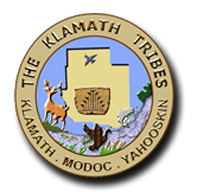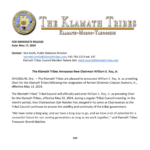CHILOQUIN, Ore. – The U.S. Department of the Interior on Feb. 14 announced a “historic agreement with the Klamath Tribes, Yurok Tribe, Karuk Tribe, and Klamath Water Users Association to advance collaborative efforts to restore the Klamath Basin ecosystem and improve water supply reliability for Klamath project agriculture. The Department also announced more than $72 million in new investments – including funding from President Biden’s Investing in America agenda – for ecosystems.”
Klamath Tribes Chairman Clayton Dumont, Secretary Roberta Frost, and Ambodat Director Mark Buettner were actively involved with the department to address concerns and funds needed to begin the extensive projects necessary to restore the Klamath Basin ecosystem. “We’ve been talking to the Department of Interior about the need for ecosystem restoration for decades,” said Dumont. “It just so happens that funding is available this year.”
Buettner said the funding package would support Klamath Falls National Fish Hatchery, which is a U.S. Fish and Wildlife Service-operated facility focused on preventing the extinction of the c’waam and koptu in Upper Klamath Lake. “The Tribes are also receiving funding to support a sucker-rearing program to avoid the extinction of these species,” he said. “This is a stopgap measure as we continue to restore water quality and habitat in Upper Klamath Lake and move towards a healthier ecosystem that will support sucker survival and recruitment, eventually leading to harvestable numbers of c’waam and koptu.”
Buettner added that the investment will fully fund the completion of the Klamath Falls National Fish Hatchery by 2027, and $64 million has been allocated for regional ecosystem repair. He said $1 million would be allocated annually over a five-year period to support the Ambodat c’waam and koptu rearing program.
Dumont highlighted where some of the funding will be distributed to the Tribes, stating that $2 million will be used for the Upper Williamson River restoration, which will be focused on the Klamath Marsh. There’s $922,459 that the Klamath Tribes will partner on to do restoration work in the Bootleg Fire scar.
“We aren’t directly receiving the $4 million for the Barnes Agency wetland restoration, but that’s something that we have fought really, really hard to have put back in place,” Dumont said. “There’s also $1.8 million for habitat improvement down on what used to be Lower Klamath Lake, reconnecting the Klamath River to the Klamath National Wildlife Refuge, and we’re partners with the Klamath Drainage District for the feasibility study to happen down there; that’s something that we’d like to see happen.”
Buettner said the $922,459 funding will also allow the Ambodat Department to support eight tribal members who are part of the department’s stream restoration team. “The intent is that there will be annual funding to support that crew, which has, over the last two years, done some major restoration work in the tributaries above Upper Klamath Lake. So that’s been very exciting, and good progress is being made,” he said.
Although the $72 million allocated by the Department of the Interior is a significant infusion of funding for ecosystem restoration, Frost said much more is needed to completely restore the Upper Klamath Basin to what it once was during tribal times prior to agricultural development. “It’s not going to make a dent,” she said. “It’s more than we’ve gotten at one time in the past, but there’s lots of restoration to do that. After 100 years of degradation, there’s a lot to do, and we’re going to continue working on it.”
“I think it’s restoration funding that we’ve been looking for, for decades,” she added, “and this is just a continuation of what the Tribes is about, restoring the homelands to what it was before in historic times.”
Buettner reiterated the need for the Tribes to be a major player in the ongoing restoration work of the Upper Klamath Basin. “That’s the Tribes’ homeland, and there’s interest and passion by the tribal community to support this restoration effort and want to be a major player in accomplishing that both on federal Forest Service lands, as well as some of the private lands, that are in their former homeland.”
More funding from the federal government is expected in the coming years for restoration work, said Dumont. In addition to the Ambodat work, he said the Tribes Natural Resources Department Director will oversee upland forest-related projects to address water quality and quantity issues.
Frost said she doesn’t want to downplay the federal funding received by the Department of the Interior and what the Tribes have accomplished with the investment of federal funds to restore the Upper Klamath Basin. “You know, we’ve hit brick walls with other administrations, so we’re happy about them looking at the Klamath Basin and providing this much funding,” she said.
Dumont said this federal funding came after a lengthy process of many meetings over the years with the federal government, and both Buettner and Frost were involved in these meetings. “A lot of these meetings were very intense, and just people unloading anger,” he said. “Deputy Assistant Secretary Matthew Strickler has done a really, really good job of managing all of that and getting us to the point where we’re sitting down and talking about where the most bang for the buck in terms of restoration dollars is and where those resources should be spent. So, I agree with the Secretary. I don’t want to downplay that part of the accomplishment. I just don’t want our members to think that the agreement is more than it is.”





